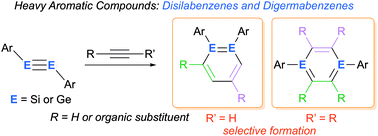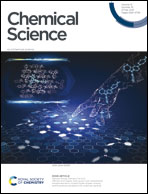Disila- and digermabenzenes†
Abstract
Reactions of isolable disilynes and digermynes with alkynes can result in the formation of the corresponding disila- (DSBs) and digermabenzenes (DGBs), wherein two carbon atoms of the benzene ring are replaced by silicon or germanium atoms. Detailed structural and spectroscopic analyses of these DSBs and DGBs have revealed that they exhibit considerable aromaticity, comparable to that of benzene. However, in contrast to the all-carbon system benzene, these DSBs and DGBs are highly reactive toward small molecules such as oxygen, hydrogen, 1,3-dienes, and water. During the investigation of their reactivity, we discovered that a 1,2-DGB works as a catalyst for the cyclotrimerization of arylalkynes, which provides access to the corresponding 1,2,4-triarylbenzenes. In this perspective article, our recent progress in the area of DSB and DGB chemistry is summarized.

- This article is part of the themed collection: Chemical Science Recent Perspective articles


 Please wait while we load your content...
Please wait while we load your content...